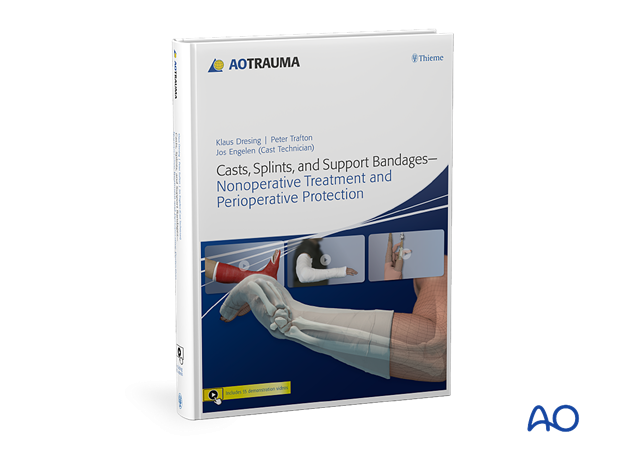Lower limb
1. General introduction to nonoperative fracture care
Klaus Dresing and Jos Engelen are presenting a live interactive Webcast.
Learning goals
- Describe the characteristics of the different casting materials.
- Explain the principles of cast application.
- Define the basic steps of post application treatment.
- Recognize potential for and prevent complications.
- Apply casts and splints and prescribe orthoses.
2. Videos from "Casts, Splints, and Support Bandages—Nonoperative Treatment and Perioperative Protection"
Introduction
The below videos are taken from the AO Publication "Casts, Splints, and Support Bandages - Nonoperative treatment and perioperative protection" edited by Klaus Dresing, Peter Trafton, and Jos Engelen. This publication examines the principles, methods, and techniques for applying a modern plaster or synthetic cast for the treatment of fractures, ligament, nerve, and soft-tissue injuries, overload injuries, and infections. It includes access to 55 cast and splint demonstrations on high-quality online video.
The book can be purchased both as a hard copy and as a E-Book.

Antirotation short leg cast
Synthetic, combicast techniqueIndications
- Traumatic hip dislocation
- Hip dislocation after arthroplasty
Goal
- To prevent rotation of the leg
Cylinder long leg cast
Synthetic, combicast techniqueIndications
- Fracture of the distal femur
- Fracture of the proximal tibia
- Fracture of the patella
- Ligamentous rupture of the knee
Goal
- Stabilization of the knee joint
Dorsal long leg splint
Plaster of ParisIndications
- Fracture of the tibia
- Fractures around the knee
Goal
- Stabilization of the knee and lower leg
Dorsal short leg splint
Plaster of ParisIndications
- Fracture of the ankle
- Fracture of the tarsal bones
- Ligamentous ruptures
Goal
- Stabilization of the ankle joint and foot
Indications
- Fracture of the ankle
- Fracture of the tarsal bones
- Ligamentous ruptures
Goal
- Stabilization of the ankle joint and foot
Fifth metatarsal cast
Synthetic, combicast techniqueIndications
- Fracture of the proximal fifth metatarsal
- Fracture of the ankle, type Weber A
- Avulsion fracture of the medial malleolus
Goal
- Stabilization of the ankle joint and the tarsus
First toe orthosis
Synthetic, combicast techniqueIndications
- Fracture of the first toe
- Perioperative protection after hallux valgus surgery
Goal
- Stabilization of the first toe and first ray
Foot cast
Synthetic, combicast techniqueIndications
- Fracture of the metatarsals
- Fracture of tarsals
- Postoperative treatment after osteosynthesis of tarsals and metatarsals
Goal
- Stabilization of hindfoot, midfoot and forefoot
Hinged knee brace
Indications
- Fracture of the diaphyseal and distal femur
- Fracture of the proximal tibia
- Knee dislocations and ligamentous lesions
- As an alternative to a prefabricated orthosis
- This hinged brace is not for primary care
Goal
- Stabilization of the knee allowing limited motion of knee joint
- Functional treatment of the knee
Long leg cast
Plaster of ParisIndications
- Fracture of the distal femur
- Fracture of the proximal tibia
- Fracture of the tibial shaft
Goal
- Stabilization of the distal upper leg and the lower leg
Indications
- Fracture of the distal femur
- Fracture of the proximal tibia
- Fracture of the tibial shaft
Goal
- Stabilization of the distal upper leg and the lower leg
One-and-a-half leg hip spica cast
Plaster of ParisIndications
- Pediatric fracture of the femur
Goal
- Stabilization of the leg and hip
Removable ankle splint
Synthetic, combicast techniqueIndications
- Postoperative protection after ankle osteosynthesis
- Nondisplaced ankle fractures
- Ligamentous ruptures
- Ankle sprain
- Fracture of the proximal fifth metatarsal
Goal
- Stabilization of the ankle joint
Removable fifth metatarsal cast
Synthetic, combicast techniqueIndications
- Fracture of the proximal fifth metatarsal
- Fracture of the ankle, type Weber A
- Avulsion fracture of the medial malleolus
Goal
- Stabilization of the ankle joint and the tarsus
Removable foot cast
Synthetic, combicast techniqueIndications
- Fracture of the metatarsals
- Fracture of tarsals
- Postoperative treatment after osteosynthesis of tarsals and metatarsals
Goal
- Stabilization of hindfoot, midfoot and forefoot
Sarmiento (patella tendon bearing) cast
Plaster of ParisIndications
- Stable diaphyseal fractures of the tibia limited to the distal two-thirds of the tibial shaft
- Primary unstable tibial fractures at the hard callus formation stage
Goal
- Stabilization of the lower leg
Sarmiento tibial brace
Synthetic, combicast techniqueIndications
- Some diaphyseal fractures of the tibia
- Not recommended for primary fracture care
Goal
- Stabilization of the tibia
Short leg cast
Rigid syntheticIndications
Secondary treatment of:
- Fracture of the distal tibia
- Fracture of the ankle
- Fracture of the foot
Goal
- Stabilization of the distal tibia, the ankle, and the foot
Indications
Secondary treatment of:
- Fracture of the distal tibia
- Fracture of the ankle
- Fracture of the foot
Goal
- Stabilization of the distal tibia, the ankle, and the foot
Single leg hip spica cast
Synthetic, combicast techniqueIndications
- Pediatric fracture of the femur
Goal
- Stabilization of the leg and hip
Ankle and foot bandage
Support bandagesIndications
- Ankle sprain
- Instability of the ankle joint
Goal
- Stabilization of the ankle joint
3. Webinar
Casting in Children - Indications and Techniques
Theddy Slongo is presenting an interactive webinar about casting in children discussing indications and techniques.
Learning objectives:
- Identify those fractures which are suitable for conservative treatment.
- Explain the main biomechanical principles of cast fixation.
- Recognize the difference between conventional plaster of Paris and fiber casting tape.
- Describe the steps of correct casting techniques for the most frequent indications.
- Anticipate the major risks and complications of casting.












